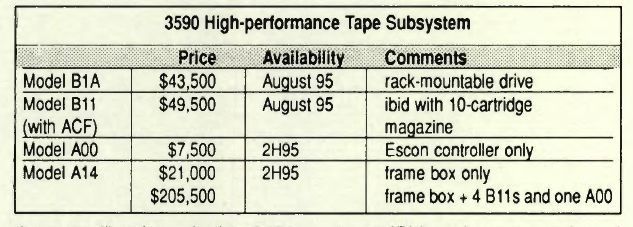History (1995): Huge Leap From 3480/3490 Cartridges With IBM Magstar 3590
Up to 12x capacity at 10GB
By Jean Jacques Maleval | March 10, 2021 at 2:16 pmIn one fell swoop, IBM Corp. (San Jose, CA) has increased capacities by more than 12x.
The new 3590s are up to 10GB, while transfer rates have climbed from 3 to 9MB/s, compared with the 3490Es.

For large computers as well as for some mid-range AS/400 units, IBM’s cartridges, launched in 1985, are the incontestable standard for backup, archiving and exchanging data, to the point of totally supplanting reel-to-reel tapes. Between 1989 and 1992, the capacity of its media has gone from 200MB (model 3480) to 800MB (3490E).
Known in the beginning by its internal code name of Blythe, then as NTP (New Tape Product, transformed in New Technology Prototype), the 3590’s new technology is based on an exterior cartridge identical to that of its predecessors, save the color.
3M is behind the new cartridges which contain, as does the 3490E, 1,100 feet of a half-inch wide tape, with a special media composed of metallic particles with a very high coercivity, 1,600Oe. 3M calls it Black Watch 3590 half-inch tape; but the technology doesn’t appear to be final.
“In the future, we count on being able to double and triple the capacity and the transfer rate,” said T. Andy Chapman, program manager, tape storage solutions at IBM in Tucson, AZ.
The magnetic recording principle is still longitudinal, but this time with 128 serpentine interleaved tracks and, not helical. In its first run, relying on a thin-film MR head 16 tracks can be written in one direction, and after moving the head up a step, 16 more tracks can be recorded in the opposite direction, etc. (see graphic below). The new MR moveable head integrates a track-following servo. That is, the highly accurate alignment is assured by 3 special tracks embedded in the tape. Four round trips are necessary to fill all of the media, with the tape moving at 2m/s. In search mode the speed goes up to 4m/s, reaching 5m/s while rewinding, thus the middle of tape can be reached in 30s.
IBM is emphasizing the advantages of longitudinal recording, which requires more simple mechanics, arriving at a better reliability for a lower maintenance price in relation to helical recording. The former, in particular, is better for applications that require frequent start-stop reading and writing. The weakest point in the announcement: the 3590 can’t read, let alone write the old 3480/3490/E media.
“The head and the electronics make up for 60% of the price of the drive. In order for it to be compatible, we would have had to double these two,” explained Chapman.
But he mentioned the possibility of coexistence between the cartridges and the drives of the new and the previous gens in 3:1. A 10-cartridge magazine auto-loader can also be added to this unit. In order to connect the 3590 to S/390 systems, which lacks an SCSI interface, a special A400 controller is required to attach them to Escon channels.
Big Blue is thinking not only of mainframe markets for its new products, but has also come up with attachments to AS/400, RISC/6000 and Sun Solaris computers, to be followed by Hewlett- Packard systems, thanks to the availability of SCSI.
The mid-range and Unix versions will be officially ready for preliminary delivery on July 28, 1995, although the mainframe model will not be ready until sometime during the second quarter, and support for the 3495 library won’t appear until the 1Q96. For certain software, the wait will be even longer, especially for the “volume stacking” option which is necessary for applications with relatively small files.
In the 3480/90/E modes, a single file takes up a cartridge. According to an IBM study on a number of major clients, half of existing cartridges currently hold less than 200MB of data. Thus for a 10GB cartridge without compression, the whole process could be quite costly, considering that at first, a 3590 cartridge will go for about 6X the price of a 3490E. IBM should finalize a new software that would bring together all of the cartridges in a complete, logical volume providing optimal file placement.
Big Blue’s first big market will be current users of the cartridge drives.
“There are just short of 100,000 3480/3490/3490E boxes worldwide,” said Bill Noble, GM, storage systems, IBM Europe.
There will be those who also have IBM 3494 or 3495 libraries. There are 700 installations worldwide.
But there is also a market that could slip through IBM’s fingers, the 7,000-some centers of StorageTek robots that only accept STK drives. What are computer managers going to do with their libraries if StorageTek fails to come up with a 3590 compatible drive, which is not at all sure? Would they go so far as to change libraries just to retain the IBM standard?
The question keeps popping up, but this time Big Blue seems to have no intentions of allowing compatible manufacturers to imitate its new technology.
“The key piece of our strategy is OEM,” clarifies Janae S. Lee, GM tape systems at IBM SSD, San Jose, CA.
Hitachi has already announced compatibility with NTP for its new libraries. EMASS Inc. (Denver, CO) is the first known company to have signed an OEM agreement with IBM for its new 3590 drives. It seems that STK, Fujitsu and others have no choice but to take orders from IBM as well.


This article is an abstract of news published on the former paper version of Computer Data Storage Newsletter on issue 87, published on April 1995.














 Subscribe to our free daily newsletter
Subscribe to our free daily newsletter


